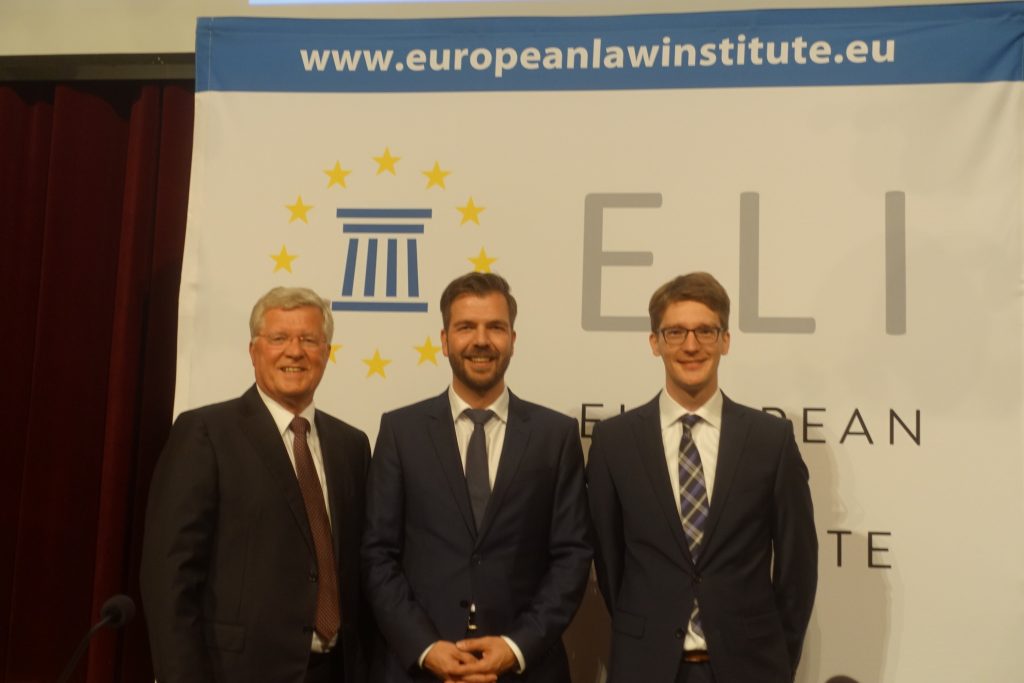Nach dem Eingang aller Berichte der National Correspondents im Jahr 2016 (siehe Beitrag) haben Prof. Bob Wessels und ich im Sommer 2017 unseren rechtsvergleichenden Bericht fertiggestellt. Er wurde auf der Jahrestagung des European Law Institute im September 2017 in Wien ohne Gegenstimme angenommen und ist nun als Instrument des ELI hier abrufbar. Eine Veröffentlichung des Berichts in Buchform ist für das erste Quartal 2018 bei Oxford University Press geplant. Dort sollen zeitgleich auch die Länderberichte (insgesamt ca. 1.100 Seiten) erscheinen.
Bob and I (left and center on the photo, with project assistant Gert-Jan Boon) are pleased to report that last week, during the General Assembly and Annual Conference of the European Law Institute (ELI) in Vienna, our report ‘Rescue of Business in Insolvency Law’ was approved as an official ELI Instrument.
The Report consists of 115 recommendations explained on more than 375 pages. Its ten chapters contain recommendations on a variety of themes affected by the rescue of financially distressed businesses: (1) Actors and procedural design, (2) Financing a rescue, (3) Executory contracts, (4) Ranking of creditor claims; governance role of creditors, (5) Labour, benefit and pension issues, (6) Avoidance transactions in out-of-court workouts and pre-insolvency procedures and possible safe harbours, (7) Sales on a going-concern basis, (8) Rescue plan issues: procedure and structure; distributional issues, (9) Corporate group issues, and (10) Special arrangements for small and medium-sized enterprises (SMEs) including natural persons (but not consumers). The Report also includes a glossary of terms and expressions commonly used in restructuring and insolvency matters.
We as Reporters feel that the Report is timely and may have a significant and positive impact on the harmonisation efforts of the European Commission as laid down in the November 2016 Proposal for a Directive on preventive restructuring frameworks. The topics addressed in the Report are intended to present a tool for better regulation in the EU, developed in the spirit of providing a coherent, dynamic, flexible and responsive European legislative framework for business rescue. Mindful of the European Commission’s commitment to better legal drafting, the Report’s proposals are formulated as comprehensibly, clearly, and as consistently as possible. Still, the recommendations are not designed to be overly prescriptive of specific outcomes, given the need for commercial flexibility and in recognition of the fact that parties will bargain in the ‘shadow of insolvency law’. The Report is addressed to the European Union, Member States of the EU, insolvency practitioners and judges, as well as scholars. The targeted group many times flows explicitly from the text of a recommendation or the context in which such a recommendation is developed and presented.
We cherish the belief that the report will assist in taking a next, decisive step in the evolutionary process of the European side of business rescue and insolvency law.
The suggested citation is either:
Wessels, Bob and Madaus, Stephan, Business Rescue in Insolvency Law – an Instrument of the European Law Institute (September 6, 2017). Available at SSRN: https://ssrn.com/abstract=3032309,
or alternatively
Wessels, Bob and Madaus, Stephan, Business Rescue in Insolvency Law – an Instrument of the European Law Institute (September 2017). Available at http://www.europeanlawinstitute.eu/fileadmin/user_upload/p_eli/Publications/Instrument_INSOLVENCY.pdf.

